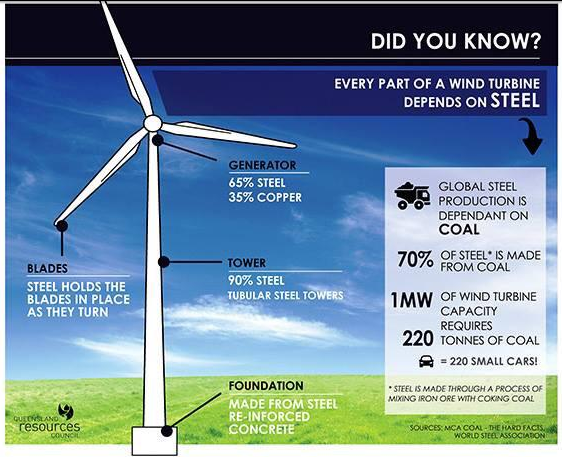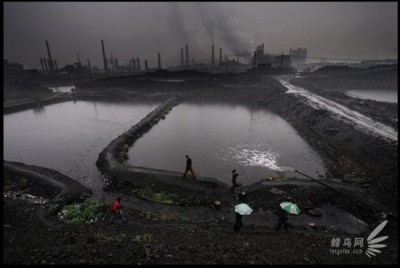Mike Moore’s Planet of The Humans revealed the wholesale environmental destruction caused by wind and solar; the climate cult naturally hated it.
The scale of the environmental havoc caused giant wind and solar farms is out of all proportion to the economic benefits they provide; if any. Apart from the subsidies these so-called ‘industries’ attract, STT can’t think of any.
Wiping out entire forest habitats is all part of our ‘inevitable’ transition to a wind powered future. Across Germany, millions of acres of forest have been clear-felled and great swathes cut through others, to allow some 30,000 of these things to be speared across Deutschland.
The same wanton destruction has been integral to Scotland’s wind power disaster, where, so far, 13,900,000 trees have been chainsawed and/or bulldozed out of existence.
But the destruction of critical wildlife habitat is only the beginning. Now, environmental researchers are having second thoughts about purportedly ‘planet saving’ wind and solar.
Renewable energy production will exacerbate mining threats to biodiversity
Watts Up With That?
Charles Rotter
3 September 2020
This was just published in Nature Communications.
That’s gonna leave a mark.
Here is the Abstract, (emphasis mine):
Renewable energy production is necessary to halt climate change and reverse associated biodiversity losses. However, generating the required technologies and infrastructure will drive an increase in the production of many metals, creating new mining threats for biodiversity. Here, we map mining areas and assess their spatial coincidence with biodiversity conservation sites and priorities.
Mining potentially influences 50 million km2 of Earth’s land surface, with 8% coinciding with Protected Areas, 7% with Key Biodiversity Areas, and 16% with Remaining Wilderness. Most mining areas (82%) target materials needed for renewable energy production, and areas that overlap with Protected Areas and Remaining Wilderness contain a greater density of mines (our indicator of threat severity) compared to the overlapping mining areas that target other materials.
Mining threats to biodiversity will increase as more mines target materials for renewable energy production and, without strategic planning, these new threats to biodiversity may surpass those averted by climate change mitigation.
This is not convenient.
Here they discuss “Future mining threats to biodiversity”.
The global area influenced by mining will almost certainly grow in extent and density in future, and the increased demand for renewable energy technologies and infrastructure will likely be one contributing factor. While diverting some of the materials used in non-renewable energy infrastructure may minimize threats of renewable energy production to biodiversity, fossil fuels will still likely play an important role in meeting the future energy demands of a growing global population. We discovered a greater proportion of pre-operational mines targeting materials needed for renewable energy production (83.9%) compared to operational mines targeting these materials (72.8%; Supplementary Table 2), and that pre-operational mining areas targeting the materials critical for renewables also seem more dense than those targeting other materials (3.2 vs. 2.7; Supplementary Table 2). Increasing the extent and density of mining areas will obviously cause additional threats to biodiversity, and our analysis reveals that a greater proportion of mines targeting materials for renewable energy production may further exacerbate threats to biodiversity in some areas (here demonstrated by their increased mining density within Key Biodiversity Areas and Remaining Wilderness at the global scale).
Careful strategic planning is urgently required to ensure that mining threats to biodiversity caused by renewable energy production do not surpass the threats averted by climate change mitigation and any effort to slow fossil fuel extraction and use. Habitat loss and degradation currently threaten >80% of endangered species, while climate change directly affects 20%37. While we cannot yet quantify potential habitat losses associated with future mining for renewable energies (and compare this to any reduced risks of averting climate change), our results illustrate that associated habitat loss could be a major issue. At the local scale, minimizing these impacts will require effective environmental impact assessments and management. Importantly, all new projects must adhere strictly to the principals of the Mitigation Hierarchy38, where biodiversity impacts are first avoided where possible before allowing compensation activities elsewhere. While compensation may help to overcome some of the expected biodiversity impacts of mining in some places39, rarely does this approach achieve No Net Loss outcomes universally39,40.
There is urgent need to understand the size of mining risks to biodiversity (climate change, and efforts to avert it) and strategically account for them in conservation plans and policies. Yet, none of these potential tradeoffs are seriously considered in international climate policies3, nor are new mining threats addressed in global discussions around post-2020 United Nation’s Strategic Plan for Biodiversity28,41. Necessary actions include strengthening policies to avoid negative consequences of mining in places fundamentally important for conservation outcomes, and developing necessary landscape plans that explicitly address current and future mining threats. These actions must also be supported by a significant research effort to overcome current knowledge deficits. A systematic understanding of the spatially explicit consequences (rather than potential threats, as investigated here) of various mining activities on specific biodiversity features, including those that occur in marine systems and at varying distances from mine sites (rather than within a predefined distance of 50 km, as done here), is required.
Green vs Green?



the posterchild of solar greenwashing absuridity happens in my city the only one in western canada with its own hydro electric plant puts solar panels at the dam https://thebcsolarscam.blogspot.com/2020/04/the-real-engineering-report-on.html
On the weekend, I travelled through rural Ontario, scanning the countryside in all of it’s gorgeous fall colours. The geographic beauty of the Niagara Escarpment and Georgian Bay, along the way to Collingwood was stunning. Industrial wind turbines sited amidst such beauty, are symbols of sheer stupidity. I felt so sorry for the many residents whose otherwise exquisite real estate is now impacted by this failed experiment.
Reblogged this on Boudica BPI Weblog and commented:
H/T gds44
Reblogged this on Gds44's Blog.
While all of this is important, more important is the fact that intermittent wind and solar power has zero value on the power grid without a massive amount of energy storage.
The amount of energy storage needed to stabilize the grid, and avoid blackouts, approaches infinity, well beyond today’s capabilities and well beyond the foreseeable future.
The sacrifices we are asked to make for 100% renewables are for nothing in return!